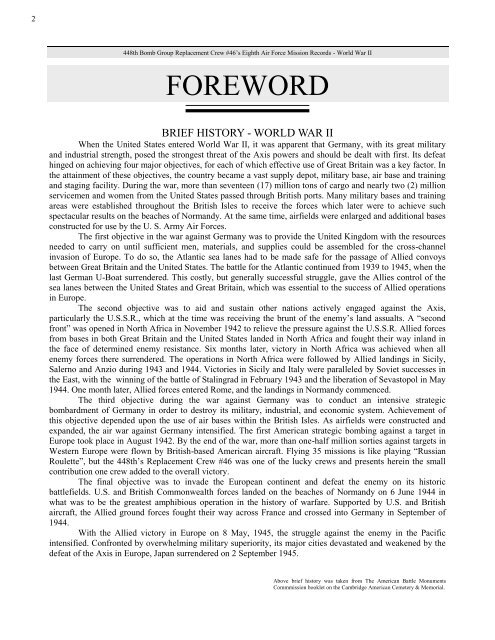ROWE MISSION #8 - 3 October, 1944, Tuesday
ROWE MISSION #8 - 3 October, 1944, Tuesday
ROWE MISSION #8 - 3 October, 1944, Tuesday
You also want an ePaper? Increase the reach of your titles
YUMPU automatically turns print PDFs into web optimized ePapers that Google loves.
2<br />
448th Bomb Group Replacement Crew #46’s Eighth Air Force Mission Records - World War II<br />
FOREWORD<br />
BRIEF HISTORY - WORLD WAR II<br />
When the United States entered World War II, it was apparent that Germany, with its great military<br />
and industrial strength, posed the strongest threat of the Axis powers and should be dealt with first. Its defeat<br />
hinged on achieving four major objectives, for each of which effective use of Great Britain was a key factor. In<br />
the attainment of these objectives, the country became a vast supply depot, military base, air base and training<br />
and staging facility. During the war, more than seventeen (17) million tons of cargo and nearly two (2) million<br />
servicemen and women from the United States passed through British ports. Many military bases and training<br />
areas were established throughout the British Isles to receive the forces which later were to achieve such<br />
spectacular results on the beaches of Normandy. At the same time, airfields were enlarged and additional bases<br />
constructed for use by the U. S. Army Air Forces.<br />
The first objective in the war against Germany was to provide the United Kingdom with the resources<br />
needed to carry on until sufficient men, materials, and supplies could be assembled for the cross-channel<br />
invasion of Europe. To do so, the Atlantic sea lanes had to be made safe for the passage of Allied convoys<br />
between Great Britain and the United States. The battle for the Atlantic continued from 1939 to 1945, when the<br />
last German U-Boat surrendered. This costly, but generally successful struggle, gave the Allies control of the<br />
sea lanes between the United States and Great Britain, which was essential to the success of Allied operations<br />
in Europe.<br />
The second objective was to aid and sustain other nations actively engaged against the Axis,<br />
particularly the U.S.S.R., which at the time was receiving the brunt of the enemy’s land assualts. A “second<br />
front” was opened in North Africa in November 1942 to relieve the pressure against the U.S.S.R. Allied forces<br />
from bases in both Great Britain and the United States landed in North Africa and fought their way inland in<br />
the face of determined enemy resistance. Six months later, victory in North Africa was achieved when all<br />
enemy forces there surrendered. The operations in North Africa were followed by Allied landings in Sicily,<br />
Salerno and Anzio during 1943 and <strong>1944</strong>. Victories in Sicily and Italy were paralleled by Soviet successes in<br />
the East, with the winning of the battle of Stalingrad in February 1943 and the liberation of Sevastopol in May<br />
<strong>1944</strong>. One month later, Allied forces entered Rome, and the landings in Normandy commenced.<br />
The third objective during the war against Germany was to conduct an intensive strategic<br />
bombardment of Germany in order to destroy its military, industrial, and economic system. Achievement of<br />
this objective depended upon the use of air bases within the British Isles. As airfields were constructed and<br />
expanded, the air war against Germany intensified. The first American strategic bombing against a target in<br />
Europe took place in August 1942. By the end of the war, more than one-half million sorties against targets in<br />
Western Europe were flown by British-based American aircraft. Flying 35 missions is like playing “Russian<br />
Roulette”, but the 448th’s Replacement Crew #46 was one of the lucky crews and presents herein the small<br />
contribution one crew added to the overall victory.<br />
The final objective was to invade the European continent and defeat the enemy on its historic<br />
battlefields. U.S. and British Commonwealth forces landed on the beaches of Normandy on 6 June <strong>1944</strong> in<br />
what was to be the greatest amphibious operation in the history of warfare. Supported by U.S. and British<br />
aircraft, the Allied ground forces fought their way across France and crossed into Germany in September of<br />
<strong>1944</strong>.<br />
With the Allied victory in Europe on 8 May, 1945, the struggle against the enemy in the Pacific<br />
intensified. Confronted by overwhelming military superiority, its major cities devastated and weakened by the<br />
defeat of the Axis in Europe, Japan surrendered on 2 September 1945.<br />
Above brief history was taken from The American Battle Monuments<br />
Commmission booklet on the Cambridge American Cemetery & Memorial.


